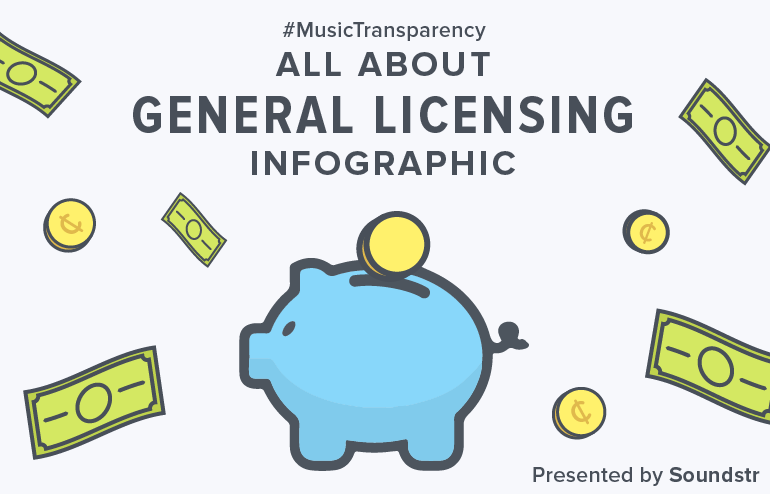[vc_row][vc_column][vc_column_text]Editor’s Note: This infographic is intended to visualize the world of General Licensing and how proposed changes could affect songwriters and music licensees. For more information, please check out the proposed SXSW 2017 Panel, “General Licensing: Where Are My Royalties?” (Votes are also encouraged; voting ends 9/2/16.)[/vc_column_text][vc_separator][vc_custom_heading text=”SHARING:
” font_container=”tag:h4|text_align:left|color:%231674d1″ use_theme_fonts=”yes”][vc_column_text css=”.vc_custom_1473699143412{padding-top: 10px !important;}”]We encourage you to share this infographic image or download a printable PDF (with links), along with the hashtag #MusicTransparency on Facebook, Twitter and beyond. We kindly ask that you use it in its entirety and do not edit in any way. Thank you for respecting our work.[/vc_column_text][/vc_column][/vc_row][vc_row][vc_column][vc_single_image image=”75918″ img_size=”full”][/vc_column][/vc_row][vc_row][vc_column][thememove_button open_new_tab=”1″ text=”Download Image” url=”http://44.193.39.137/wp-content/uploads/2016/08/Soundstr-General-Licensing-Infographic.png” icon=”vc_icon_element-icon fa fa-file-image-o”][thememove_button open_new_tab=”1″ text=”Download the PDF” url=”http://44.193.39.137/wp-content/uploads/2016/08/Soundstr-General-Licensing-Infographic.pdf” icon=”vc_icon_element-icon fa fa-file-pdf-o”][/vc_column][/vc_row][vc_row][vc_column][vc_custom_heading text=”CREATORS:
” font_container=”tag:h4|text_align:left|color:%231674d1″ use_theme_fonts=”yes”][vc_column_text css=”.vc_custom_1469753639445{padding-top: 10px !important;}”]Soundstr uses recognition technology to identify real world music usage and offers new advertising opportunities for businesses and songwriters. This transparency offers businesses a way to negotiate PRO license fees based on actual music usage, and songwriters a way to earn royalties when their music is used in the real world. Soundstr is a venture-backed startup, founded by songwriters and leverages best-in-class recognition technology by Gracenote (Tribune). Click here to learn more about Soundstr.[/vc_column_text][vc_text_separator title=”SOURCES” i_icon_fontawesome=”fa fa-link” i_size=”sm” add_icon=”true”][vc_column_text]
- #1 (1/2): “Research Confirms: Music Builds Business” SOCAN. May 6, 2014: https://www.socan.ca/news/research-confirms-music-builds-business
- #1 (2/2): Lubin, Gus “8 Amazing Effects Background Music Has on Sales” Business Insider. July 21, 2011: http://www.businessinsider.com/effects-of-music-on-sales-2011-7
- #2: “CISAQ Global Collections Report 2015 (for 2014 Data)” CISAQ: http://www.cisac.org/Media/Studies-and-Reports/Publications/CISAC-GCR2015_EN
- #3: Gisselberg, Tonya “DMX Case Forces ASCAP and BMI to Adjust Rates to Account for DMX’s Direct Licenses with Composers and Publishers” Seattle Copyright Watch. June 21, 2012: http://www.seattlecopyrightwatch.com/copyright/public-performance-right/dmx-cases-force-ascap-and-bmi-to-adjust-rates-to-account-for-dmxs-direct-licenses-with-composers-and/
- #4: There are some exceptions, like when a performing artist submits a setlist to a PRO through ASCAP, OnStage or BMI Live. SESAC uses Pollstar data (which only tracks the top concerts). GMR allows for private setlist submission for artists on their roster. Multiple sources:
- #5: Howard, George “From Modeling to Measuring: A Blockchain Solution for Music At Political Events” Forbes. July 27, 2016: http://www.forbes.com/sites/georgehoward/2016/07/27/from-modeling-to-measuring-a-blockchain-solution-for-music-at-political-events/#263f64ab425f
- #6 (1/2): “BMI Reports Record-Breaking Revenue of Over $1 Billion” BMI. September 10, 2015: http://www.bmi.com/press/entry/572180
- #6 (2/2): Christman, Ed “ASCAP Report $1 Billion in Revenue, Again” Billboard. April 28, 2016: http://www.billboard.com/articles/news/7348576/ascap-reports-1-billion-revenue
- #7: Assumes background providers pay $50 per location per year to each ASCAP and BMI. This is higher than adjudicated rates to account for unaccounted variables in the estimated breakdown.
- Gisselberg, Tonya “DMX Case Forces ASCAP and BMI to Adjust Rates to Account for DMX’s Direct Licenses with Composers and Publishers” Seattle Copyright Watch. June 21, 2012: http://www.seattlecopyrightwatch.com/copyright/public-performance-right/dmx-cases-force-ascap-and-bmi-to-adjust-rates-to-account-for-dmxs-direct-licenses-with-composers-and/
- Breakdown assumes 50,000 locations from PlayNetwork and 400,000 US locations from Mood Media. PlayNetwork operates 110,000 locations in 110 countries. Mood Media operates 500,000 locations in 100 countries. Neither offers breakdowns by country.
- #8: BMI Annual Review 2015: http://www.bmi.com/pdfs/publications/2015/BMI_Annual_Review_2015.pdf
- #9: Some of these songwriters had songs on the radio during this time period and within the market. Those songs were not ones identified in the study’s test sites and therefore these songwriters would not receive compensation for the use of those specific songs.
[/vc_column_text][vc_text_separator title=”RELATED POST” i_icon_fontawesome=”fa fa-file-text-o” i_size=”sm” add_icon=”true”][vc_column_text]
- Penick, Brian. “5 Things Songwriters Need to Know About the Consent Decree” – Soundstr Blog, July 13, 2016 https://44.193.39.137/5-things-consent-decree/
Credits:
• Artwork: Corey Donovan & Joey Brennan
• Copy: Eron Bucciarelli-Tieger (@EronBucciarelli) & Brian Penick (@BrianPenick)



